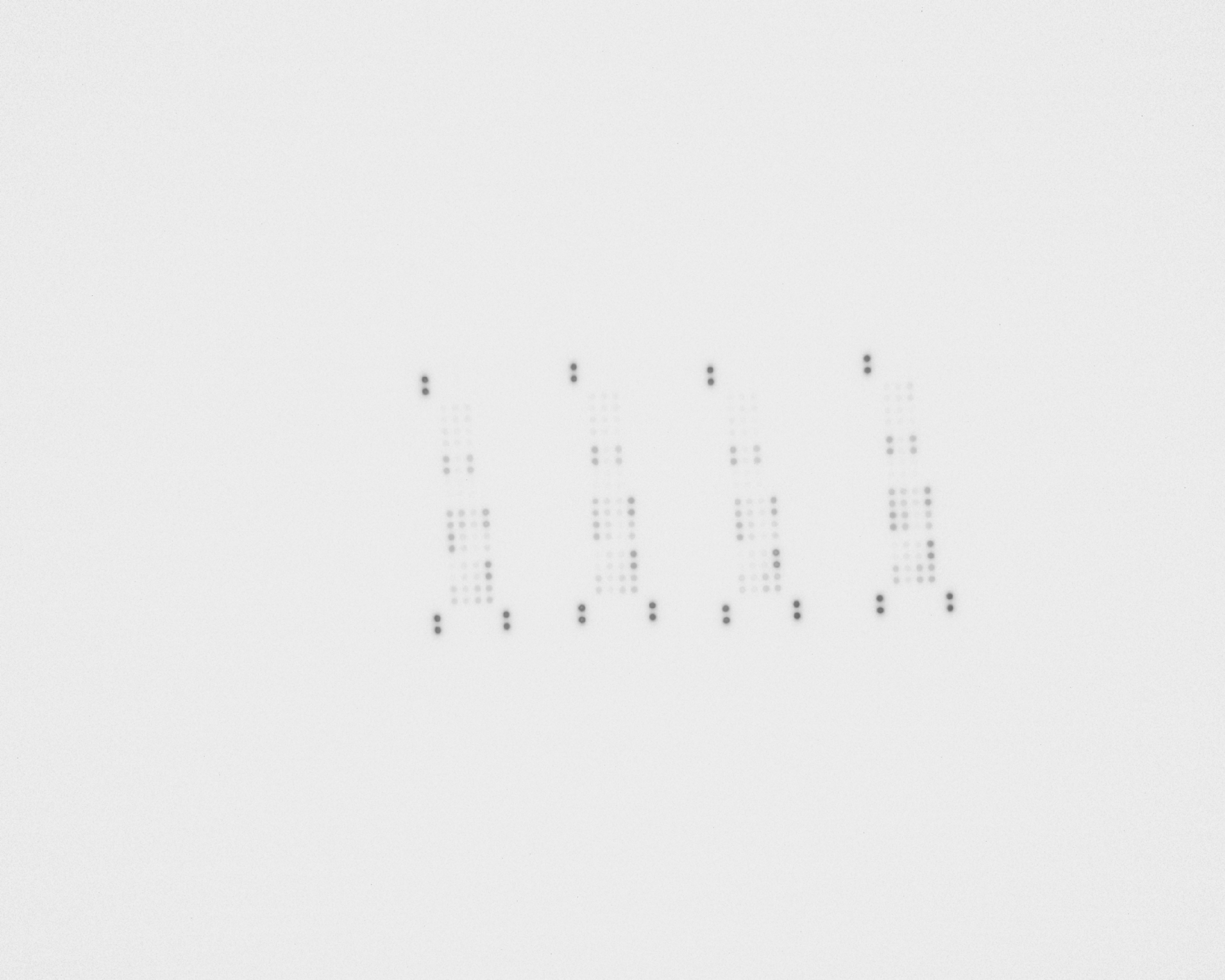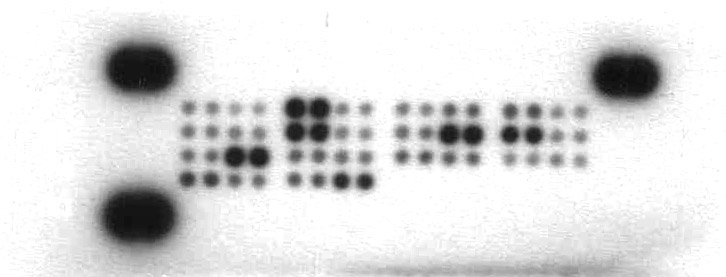Proteome Profiler Mouse Chemokine Array Kit
Proteome Profiler Mouse Chemokine Array Kit Summary
A membrane-based antibody array for the parallel determination of the relative levels of selected mouse chemokines. Validated for analyte detection in cell culture supernates, cell lysates, tissue lysates and serum.
Troubleshooting Guide
Key Benefits
- Detects 25 mouse chemokines simultaneously
- Requires no specialized equipment
Principle of the Array
The Proteome Profiler Mouse Chemokine Array Kit is a membrane-based sandwich immunoassay. Samples are mixed with a cocktail of biotinylated detection antibodies (Step 1) and then incubated with the array membrane which is spotted in duplicate with capture antibodies to specific target proteins (Step 2). Captured proteins are visualized using chemiluminescent detection reagents (Step 3). The signal produced is proportional to the amount of analyte bound.
Why Use an Antibody Array to Detect Cell Stress-Related Proteins?
Determining the expression of multiple chemokines in a single sample can be expensive, time consuming and can require specialized equipment. Performing multiple immunoprecipitations and Western blots requires time, labor, and reagents. The use of a multiplex antibody array to detect multiple proteins in a single sample can be cost-effective and also save time and sample.
- 4 Array Membranes
- 4-Well Multi-dish
- Array Buffers
- Wash Buffer
- Detection Antibody Cocktail
- Streptavidin-HRP
- Chemiluminescent Detection Reagents
- Transparency Overlay Template
- Detailed Protocol
For a complete list of the kit contents and necessary materials, please see the Materials Provided/Other Supplies Required sections of the product datasheet.
Stability and Storage
Store the unopened kit at 2 °C to 8 °C. Do not use past kit expiration date.
| Simultaneously detect the levels of these chemokines in a single sample. | ||
| CCL11/Eotaxin | CCL6/C10 | CXCL11/I-TAC |
| CCL12/MCP-5 | CCL8/MCP-2 | CXCL12/SDF-1 |
| CCL2/JE/MCP-1 | CCL9/10/MIP-1 gamma | CXCL13/BLC/BCA-1 |
| CCL21/6Ckine | Chemerin | CXCL16 |
| CCL22/MDC | Complement Component C5/C5a | CXCL2/MIP-2 |
| CCL27/CTACK | CX3CL1/Fractalkine | CXCL9/MIG |
| CCL28 | CXCL1/KC | IL-16 |
| CCL3/CCL4 (MIP-1 alpha /MIP-1 beta) | CXCL10/IP-10/CRG-2 | LIX |
| CCL5/RANTES | ||
Assays for analytes represented in the Mouse Chemokine Array Kit
| Analyte | Quantikine® ELISA Kits | DuoSet® ELISA Development Systems |
| CCL21/6Ckine | DY457 | |
| CXCL13/BLC/BCA-1 | MCX130 | DY470 |
| CCL6/C10 | DY487 | |
| Complement Component C5/C5a | DY2150 | |
| CCL28 | DY533 | |
| Chemerin | MCHM00 | DY2325 |
| CCL27/CTACK | DY725 | |
| CXCL16 | DY503 | |
| CCL11/Eotaxin | MME00 | DY420 |
| CX3CL1/Fractalkine | MCX310 | DY472 |
| IL-16 | DY1727 | |
| CXCL10/IP-10/CRG-2 | MCX100 | DY466 |
| CXCL11/I-TAC | DY572 | |
| CCL2/JE/MCP-1 | MJE00 | DY479 |
| CXCL1/KC | MKC00B | DY463 |
| CXCL2/MIP-2 | MM200 | DY452 |
| CCL5/RANTES | MMR00 | DY478 |
| CXCL12/SDF-1 | MCX120 | DY460 |
Specifications
Product Datasheets
Scientific Data
 View Larger
View Larger
Detection of Multiple Analytes in Cell Culture Supernate with the Mouse Chemokine Array. 3T3-L1 mouse embryonic fibroblast adipose-like cells were untreated or treated with 100 ng/mL LPS for 24 hours.
 View Larger
View Larger
Detection of Multiple Analytes in Cell Culture Supernate with the Mouse Chemokine Array. RAW264.7 mouse monocyte/macrophage cells were untreated or treated with 1 µg/mL recombinant mouse IFN-gamma (R&D Systems, Catalog # 485-MI) for 8 hours, followed by 1 µg/mL LPS for 16 hours.
Citations for Proteome Profiler Mouse Chemokine Array Kit
R&D Systems personnel manually curate a database that contains references using R&D Systems products. The data collected includes not only links to publications in PubMed, but also provides information about sample types, species, and experimental conditions.
29
Citations: Showing 1 - 10
Filter your results:
Filter by:
-
Notch3 deletion regulates HIV-1 gene expression and systemic inflammation to ameliorate chronic kidney disease
Authors: Thornton, M;Sommer, N;McGonigle, M;Ram, AK;Yerrathota, S;Ehirim, H;Chaturvedi, A;Phan, JD;Chakravarthi, PV;Gunewardena, S;Talreja, J;Singhal, P;Fields, TA;Ray, PE;Dhillon, NK;Sharma, M;
bioRxiv : the preprint server for biology 2023-09-13
-
A Role for Microsomal Glutathione Transferase 1 in Melanin Biosynthesis and Melanoma Progression
Authors: Zhang, J;Ye, ZW;Bräutigam, L;Chakraborty, P;Luo, Z;Culpepper, J;Aslam, M;Zhang, L;Johansson, K;Haeggström, JZ;Xu, J;Olsson, M;Townsend, DM;Mehrotra, S;Morgenstern, R;Tew, KD;
The Journal of biological chemistry 2023-06-13
-
Bacterial Outer Membrane Vesicles Promote Lung Inflammatory Responses and Macrophage Activation via Multi-Signaling Pathways
Authors: S Ryu, K Ni, C Wang, A Sivanantha, JM Carnino, HL Ji, Y Jin
Biomedicines, 2023-02-15;11(2):. 2023-02-15
-
The Effect of Super-Repressor IkB-Loaded Exosomes (Exo-srIkappaBs) in Chronic Post-Ischemia Pain (CPIP) Models
Authors: JS Chae, H Park, SH Ahn, EC Han, Y Lee, YJ Kim, EJ Ahn, HW Oh, HJ Lee, C Choi, YH Choi, WJ Kim
Pharmaceutics, 2023-02-07;15(2):. 2023-02-07
-
Tumor-Microenvironment Characterization of the MB49 Non-Muscle-Invasive Bladder-Cancer Orthotopic Model towards New Therapeutic Strategies
Authors: S Domingos-P, K Sathiyanad, L Polak, JA Haefliger, M Schmittnae, CH Ries, P Jichlinski, B Roth, L Derré, D Nardelli-H
International Journal of Molecular Sciences, 2022-12-21;24(1):. 2022-12-21
-
Alveolar macrophage metabolic programming via a C-type lectin receptor protects against lipo-toxicity and cell death
Authors: M Scur, AB Mahmoud, S Dey, F Abdalbarri, I Stylianide, D Medina-Lun, GS Gamage, A Woblistin, ANM Wilson, HS Zein, A Stueck, A Wight, OA Aguilar, F Di Cara, BD Parsons, MMA Rahim, JR Carlyle, AP Makrigiann
Nature Communications, 2022-11-25;13(1):7272. 2022-11-25
-
Chemokine CCL9 Is Upregulated Early in Chronic Kidney Disease and Counteracts Kidney Inflammation and Fibrosis
Authors: C Hemmers, C Schulte, J Wollenhaup, DWL Wong, E Harlacher, S Orth-Alamp, BM Klinkhamme, SH Schirmer, M Böhm, N Marx, T Speer, P Boor, J Jankowski, H Noels
Biomedicines, 2022-02-10;10(2):. 2022-02-10
-
Glucocorticoid receptor regulates PD-L1 and MHC-I in pancreatic cancer cells to promote immune evasion and immunotherapy resistance
Authors: Y Deng, X Xia, Y Zhao, Z Zhao, C Martinez, W Yin, J Yao, Q Hang, W Wu, J Zhang, Y Yu, W Xia, F Yao, D Zhao, Y Sun, H Ying, MC Hung, L Ma
Nature Communications, 2021-12-06;12(1):7041. 2021-12-06
-
High-Fat Diet-Induced Obese Effects of Adipocyte-Specific CXCR2 Conditional Knockout in the Peritoneal Tumor Microenvironment of Ovarian Cancer
Authors: D Choe, ES Lee, A Beeghly-Fa, AJ Wilson, MM Whalen, SE Adunyah, DS Son
Cancers, 2021-10-08;13(19):. 2021-10-08
-
Discovery of chemerin as the new chemoattractant of human mesenchymal stem cells
Authors: I Kim, H Park, I Hwang, D Moon, H Yun, EJ Lee, HS Kim
Cell & bioscience, 2021-07-01;11(1):120. 2021-07-01
-
In situ neutrophil efferocytosis shapes T cell immunity to influenza infection
Authors: K Lim, TH Kim, A Trzeciak, AM Amitrano, EC Reilly, H Prizant, DJ Fowell, DJ Topham, M Kim
Nat. Immunol., 2020-08-03;0(0):. 2020-08-03
-
CCL2 and CXCL12 Derived from Mesenchymal Stromal Cells Cooperatively Polarize IL-10+ Tissue Macrophages to Mitigate Gut Injury
Authors: J Giri, R Das, E Nylen, R Chinnadura, J Galipeau
Cell Rep, 2020-02-11;30(6):1923-1934.e4. 2020-02-11
-
Microphthalmia-Associated Transcription Factor (MITF) Regulates Immune Cell Migration into Melanoma
Authors: GM Wiedemann, C Aithal, A Kraechan, C Heise, BL Cadilha, J Zhang, P Duewell, R Ballotti, S Endres, C Bertolotto, S Kobold
Transl Oncol, 2018-11-28;12(2):350-360. 2018-11-28
-
Myeloid p38? signaling promotes intestinal IGF-1 production and inflammation-associated tumorigenesis
Authors: C Youssif, M Cubillos-R, M Comalada, E Llonch, C Perna, N Djouder, AR Nebreda
EMBO Mol Med, 2018-07-01;0(0):. 2018-07-01
-
Molecular and cellular identification of the immune response in peripheral ganglia following nerve injury
Authors: JA Lindborg, JP Niemi, MA Howarth, KW Liu, CZ Moore, D Mahajan, RE Zigmond
J Neuroinflammation, 2018-06-26;15(1):192. 2018-06-26
-
The hyaluronic acid-rich node and duct system is a structure organized for innate immunity and mediates the local inflammation
Authors: BK Choi, SH Hwang, YI Kim, R Singh, BS Kwon
Cytokine, 2018-06-12;0(0):. 2018-06-12
-
Chlamydia and Lipids Engage a Common�Signaling Pathway That Promotes Atherogenesis
Authors: S Chen, K Shimada, TR Crother, E Erbay, PK Shah, M Arditi
J. Am. Coll. Cardiol., 2018-04-10;71(14):1553-1570. 2018-04-10
-
RNA-based micelles: A novel platform for chemotherapeutic drug loading and delivery
Authors: Y Shu, H Yin, M Rajabi, H Li, M Vieweger, S Guo, D Shu, P Guo
J Control Release, 2018-02-14;0(0):. 2018-02-14
-
NK Cells Stimulate Recruitment of cDC1 into the Tumor Microenvironment Promoting Cancer Immune Control
Authors: JP Böttcher, E Bonavita, P Chakravart, H Blees, M Cabeza-Cab, S Sammicheli, NC Rogers, E Sahai, S Zelenay, C Reis E Sou
Cell, 2018-02-08;172(5):1022-1037.e14. 2018-02-08
-
SSeCKS/AKAP12 scaffolding functions suppress B16F10-induced peritoneal metastasis by attenuating CXCL9/10 secretion by resident fibroblasts
Authors: M Muramatsu, L Gao, J Peresie, B Balderman, S Akakura, IH Gelman
Oncotarget, 2017-08-09;8(41):70281-70298. 2017-08-09
-
Sitagliptin, a dipeptidyl peptidase-4 inhibitor, suppresses CXCL5 and SDF-1 and does not accelerate intestinal neoplasia formation in Apc(Min/+) mice fed a high-fat diet
Authors: K Fujiwara, T Inoue, Y Henmi, Y Hirata, Y Naka, A Hara, K Kakimoto, S Nouda, T Okada, K Kawakami, T Takeuchi, K Higuchi
Oncol Lett, 2017-08-01;14(4):4355-4360. 2017-08-01
-
Stromal Cell-Derived Factor 1 Mediates Immune Cell Attraction upon Urinary Tract Infection
Authors: B Isaacson, T Hadad, A Glasner, C Gur, Z Granot, G Bachrach, O Mandelboim
Cell Rep, 2017-07-05;20(1):40-47. 2017-07-05
-
Effect of low-level CO2 on innate inflammatory protein response to organic dust from swine confinement barns
Authors: D Schneberge, JM DeVasure, KL Bailey, DJ Romberger, TA Wyatt
J Occup Med Toxicol, 2017-03-24;12(0):9. 2017-03-24
-
Unliganded estrogen receptor alpha regulates vascular cell function and gene expression
Authors: Richard H Karas
Mol. Cell. Endocrinol., 2016-11-22;442(0):12-23. 2016-11-22
-
Novel chemokine-like activities of histones in tumor metastasis
Authors: R Chen, Y Xie, X Zhong, Y Fu, Y Huang, Y Zhen, P Pan, H Wang, DL Bartlett, TR Billiar, MT Lotze, HJ Zeh, XG Fan, D Tang, R Kang
Oncotarget, 2016-09-20;7(38):61728-61740. 2016-09-20
-
Chemotaxis-driven disease-site targeting of therapeutic adult stem cells in dystrophic epidermolysis bullosa
Stem Cell Res Ther, 2016-08-27;7(1):124. 2016-08-27
-
Ten Weeks of Infection with a Tissue-Invasive Helminth Protects against Local Immune Complex-Mediated Inflammation, but Not Cutaneous Type I Hypersensitivity, in Previously Sensitized Mice.
Authors: Evans H, Killoran K, Mitre B, Morris C, Kim S, Mitre E
J Immunol, 2015-08-31;195(7):2973-84. 2015-08-31
-
G protein-coupled receptor kinase 6 deficiency promotes angiogenesis, tumor progression, and metastasis.
Authors: Raghuwanshi S, Smith N, Rivers E, Thomas A, Sutton N, Hu Y, Mukhopadhyay S, Chen X, Leung T, Richardson R
J Immunol, 2013-04-15;190(10):5329-36. 2013-04-15
-
Metabolomic profiling reveals mitochondrial-derived lipid biomarkers that drive obesity-associated inflammation.
Authors: Sampey BP, Freemerman AJ, Zhang J
PLoS ONE, 2012-06-12;7(6):e38812. 2012-06-12
FAQs
No product specific FAQs exist for this product, however you may
View all Proteome Profiler Antibody Array FAQsReviews for Proteome Profiler Mouse Chemokine Array Kit
Average Rating: 4.7 (Based on 6 Reviews)
Have you used Proteome Profiler Mouse Chemokine Array Kit?
Submit a review and receive an Amazon gift card.
$25/€18/£15/$25CAN/¥75 Yuan/¥1250 Yen for a review with an image
$10/€7/£6/$10 CAD/¥70 Yuan/¥1110 Yen for a review without an image
Filter by:
Mouse peritoneal macrophages










